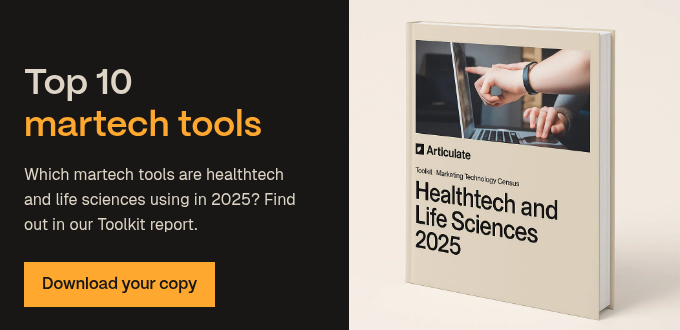As a medical technology company, you want to reach your target audience, right?
It’s not so easy, in your industry. You have a particularly diverse range of potential customers, all with very specific needs. Corporations, insurers, clinicians... To get your chosen audience’s attention, you must match your marketing processes, tools and assets to buyer concerns and motivations.
Today, we delve into what each of these audiences care about and how to approach those goals or pain points. And, we offer one actionable next step you can take to market to each of the nine specific audiences. (This won’t be the only thing you should do, of course. Head on over to our blog for more marketing best practices.)
Here are the audiences we’ll speak to today:
- The general public
- Service users
- Businesses
- Educational institutions
- Charities and research institutions
- Clinicians
- Hospitals, care homes and other institutions
- NHS trusts
- Private healthcare providers, insurers and HMOs
Marketing to the general public
We’ll start off short and sweet. MedTech has become part of our lives, though many wouldn’t call it that specifically. Think wearables like FitBit or the over 100 million Apple Watch users. Or, apps like diet trackers, sleep trackers — even period trackers. More and more, people are using these kinds of tools to manage their health, with data to monitor any changes.
The sell here is about building this kind of technology into your customers’ lifestyle. That is, to make it part of the day-to-day. Normalising its usage. What you’re not doing is bombarding people with dire warnings or restrictive advice. That’s not how you change behaviour. It’s not how to persuade people to buy.
Next step: Consider your brand story. Is it clear? Motivating? Aspirational? If you’re trying to sell a lifestyle, sell the story, sell the dream. The rest will fall into place.
Marketing to service users
The World Health Organisation estimates that 1.3 billion people experience significant disability.
This audience, many of whom are service users, are the most well-informed people in the room about their own condition. They may not have all the terminology, but they absolutely know themselves, their experiences and even their pain on an incomparable level.
When marketing to such individuals, your job is to help them articulate their condition (or their difference), guide personal research and signpost where they can go for help.
Be careful not to talk down to this audience. In the same breath, don’t use confusing jargon.
Next step: Align your content and communications campaigns with global awareness events throughout the calendar year. You want to be producing timely material that helps to raise awareness and that is up-to-date with the latest research.
Marketing to businesses
Whether you’re targeting corporations or smaller businesses, look out for core personas within the organisation. These are who you really need to appeal to. Think HR leaders, Chief Clinical or Medical Officers or even a Chief Happiness Officer.
These people care about employee wellbeing. And, they are measuring things like productivity, turnover, time off and sick leave, as well as morale and engagement. It’s well known that mental and physical health increases productivity and directly impacts the bottom line.
Next step: Reach out to your key business personas on LinkedIn (we suggest using Sales Navigator to find them). Connect with them. Give them practical tips on how to improve employee wellbeing at work and offer a partnership based on knowledge-sharing and supported company-wide initiatives, not pushy sales tactics.
Marketing to educational institutions
As with employee wellbeing in a business setting, educational institutions will be looking at student wellbeing. You could therefore take a similar approach, perhaps speaking to the things these institutions will be measuring, such as number of early leavers or results of student satisfaction surveys. For example, the highest rated university in the UK for student satisfaction in 2022 was the University of St Andrews. One of the reasons cited was the availability of the Silvercloud digital mental health platform.
You may also be targeting this audience because you offer tech that specifically helps to train young medical professionals. In this case, accessibility and affordability are key.
Next step: Educators are interested in learning too, right? So, focus on establishing your business as a thought leader — an authoritative source of information — in your industry. Start by choosing a single topic area and building a cluster of content around that subject. More on how to write thought leadership articles, here.
Marketing to charities and research institutions
It’s up to you to help these organisations see how your products and services can align with their mission. In other words, to reach this audience, you need to demonstrate the throughline between your technology and their desirable outcomes.
Use things like case studies and verifiable data to prove your worth in a succinct, clear way, showing the use cases, successes and — as much as possible — academic backing that you have.
Next step: Segment your marketing content so that you’re speaking to a specific concern, making it easy for this audience to see the benefits.
Write a series of articles, such as, ‘How X technology benefits patients living with dementia’, or ‘… helps those with MS’ or ‘… improves the standard of living for those with cerebral palsy’. Then, link each article to a central pillar page that lists all benefits of X technology.
Marketing to clinicians
Clinicians, including physicians, medical assistants, psychiatrists or other practitioners, are a tough audience. Of anyone in the medical system — particularly in the US — these are the people who are bombarded by pharmaceutical sales reps and medical technology companies alike.
Therefore, you need to demonstrate your worth as quickly as possible. They need to know how what you’re offering fits into their practice, what the benefit-to-cost ratio is, and the timeline for implementation and training.
Next step: Refine your sales proposal process. Here is where your marketing team can really help. Have your marketers put together one-pagers or curated lists of key articles, case studies or other marketing assets that can help to support and streamline the sales process. These will provide instant and valuable insight to clinicians. This way, you’ll cut through the noise.
Marketing to hospitals, care homes and other institutions
Hospitals and other institutions have complex purchasing procedures that involve multiple stakeholders.
You should familiarise yourself with the various procurement methods, such as tenders or requests for proposals (RFPs). You may need to get your business on an approved list of vendors. It’s no use trying to market your products only to stumble over this barrier to entry. That’s just wasting everyone’s time.
If you want to get on those lists, the first step is visibility — which can be achieved by attending trade shows and conventions, whether in person or online.
Next step: At your next conference, use this opportunity to get contact information into your CRM database. HubSpot is the one we use and recommend to clients. HubSpot has a nifty business card scanner app you can use to automatically populate fields in a contact record, which makes this process quick and easy.
Marketing to the UK’s National Health Service (NHS) trusts
The NHS is big part of the national identity in Britain. It is loved and respected. The NHS is also under enormous pressure on multiple fronts, from budgeting to staffing, so any partnership you can offer needs to be worth it.
Narrow your research on specific regional bodies, trusts and clinical commissioning groups (CCGs) in order to find a timely product-market fit — that is where you can do the most good, and who can afford what you offer.
That said, the NHS is also a space where innovation is encouraged. In fact, just last month five million pounds was awarded to drive cutting-edge treatments and technologies to support veterans’ healthcare. Public sector bodies, from the NHS to Crown Commercial Services or even penitentiaries, are aiming to be hubs of technological innovation with outputs that benefit the population as a whole. Speak to that aspirational goal and you’ll be onto a winner.
Next step: Build a targeted email list using public directories and the NHS database. Use personalisation to make your emails more relevant to the reader. Your primary goal is to position your business as an exciting innovator in these emails.
Marketing to private healthcare providers, insurers and HMOs
Health maintenance organisations (HMOs) and insurers are looking for medical technology products that can improve patient outcomes, reduce costs, and increase efficiency.
In order to increase their margins, insurers are looking for ways to reduce the effects and therefore cost of long-term ill health, as well as (in the US) reducing employer premiums. Plus, they may be interested in the data your technology provides, which could help them to make more data-driven decisions than their competitors.
Next step: Make a Go To Market package for this audience. This will help private healthcare providers, insurers and HMOs to incentivise their customers to try your product and stick with it for as long as possible.
Reach the right audience, with the right message
The TL;DR (too long; didn’t read) of this is that medical technology companies need to understand their target audience and adapt their marketing message accordingly.
You know this instinctively. The ‘how’ is the question.
Articulate Marketing can help you elevate your positioning and targeting, document everything, and (the most difficult bit) embed it into your marketing. We’ve done it before. We’ll do it again. If you’re a medical technology company that wants to refine your reach to grow your target customer base, we’re the right people for the job.

 Posted by
Maddy Leslie
Posted by
Maddy Leslie






